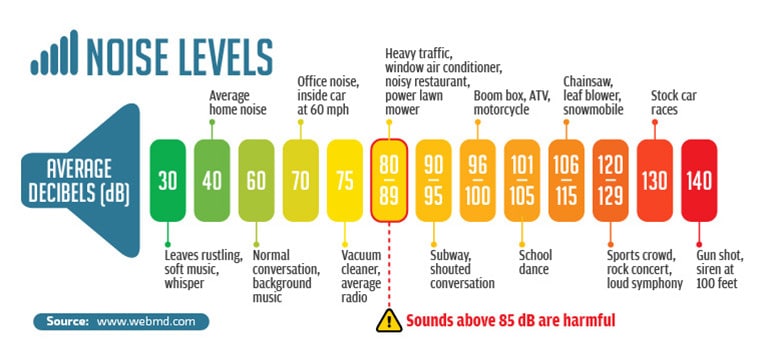Table of Contents
- 1 What makes a portable generator loud?
- 2 How loud are generators?
- 3 Why should I silence my generator?
- 4 How to Quiet a Portable Generator
- 4.1 1. Build a Generator Enclosure
- 4.2 2. Shielding the noise using plywood sheets
- 4.3 3. Replace the muffler
- 4.4 4. Use a vehicle’s muffler
- 4.5 5. Place the generator further away from you
- 4.6 6. Position the exhaust facing away from you
- 4.7 7. Place the generator behind a building or vehicle
- 4.8 8. Place it in a shed
- 5 Conclusion
Portable generators could be of great use to anyone. There is no doubt in that. They can be a life-saver during an outage. They can provide the little piece of comfort you need during boondocking. They can be the only source of power for your tools on the construction site. However, pretty much all portable generators have one major problem– noise emission. A noisy generator can be very annoying for you and especially for your neighbors by home or tent.
In this article, we will show you 8 tested and proven ways on how to make a generator quiet – from the use of mufflers to using soundproof generator sheds.
What makes a portable generator loud?
There are 2 primary sources of noise in a generator:
- Combustion of fuel in the engine – Most of the sound that you hear from a portable generator emanates from the actual combustion of fuel (diesel, gasoline, or propane) inside the motor. In addition to the burning of fuel, the rumbling of engine parts, including the pistons, valves, and crankshaft, is also responsible for noise creation.
- Quality of construction materials – Unlike the car engines, which are made of thick and heavy materials, the conventional portable generators are made of thin and lightweight ones, so they can be easily moved around. Depending on the quality of these lightweight materials, the generator’s vibrations can cause more or less noise.
How loud are generators?
Generally, the quietest portable generators fall in the range of 50 dB and 59 dB. Generators in the field of 60-74 dB are as loud as a standard vacuum cleaner and are quite manageable. Models between 75 dB and 80+ dB can be as loud as a blender set at the highest range.
An important thing to note about generator noise is that the sound tends to double with every 10 dB increment. For instance, the Champion 7500, which has a noise rating of 74 dB, is almost twice as loud as the Wen 56200i, which is rated at 51 dB.
Why should I silence my generator?
There a few common reasons why you might want to quiet a loud generator.
More often than not, people want to keep good relations with their neighbors. But having a noisy generator rattling at 75 dB is surely something that can quickly ruin these relations. Often, neighbors get into heated arguments and even fight because of general noise. Also, reducing your generator’s noise will help you and your family sleep better at night, especially if there is a light sleeper among you.
Another time when you might want to silence your generator is when camping. A camping generator can be a convenient source of power when you are miles away from the nearest power grid but its noise is something you don’t want to hear when in nature. Therefore, knowing how to make a generator quiet for camping could greatly benefit your experience with nature.
Read on and get to learn how to silence a generator when at home or campsite.
How to Quiet a Portable Generator
1. Build a Generator Enclosure
A DIY generator enclosure is one of the most comprehensive ways of silencing a generator. If done correctly, a generator enclosure is capable of reducing noise levels by up to a half. This means that you can enjoy maximum power output from a powerful portable generator while putting the noise level closer to that of an inverter.
Worth noting, this method requires a few woodworking skills. However, it does not need to be as complicated as most YouTube videos would lead you to believe.
What you’ll need
- MDF soundboard
- Circular or Table saw
- Glue and caulk
- Mass Loaded Vinyl
- Closed-cell vinyl nitrile matting
- Two 6’’ air ducts
- A pair of hinges
How to build a quiet generator enclosure
- Determine the generator’s size. Measure the size of your generator to determine the size of your quiet box. As you do this, be sure to leave a few inches on all sides to accommodate the thickness of the soundboard and insulation. Also, if you plan to add other appliances to the soundproof box, take into consideration their size as well.
- Cut the MDF board. After determining the size of all sides of the box, use a circular saw or Table saw to cut the fiberboard into the correct sizes. It might be important to label each board to prevent confusion later.
- Make ventilation holes. Your quiet generator box will require 2 ventilation ducts of at least 6 inches in diameter. One should be at the top panel towards the back, and the other one should be on a side panel on the opposite side of the top hole.
- Apply the first layer of insulation. To achieve excellent soundproofing capabilities, your generator box will require several insulation layers to aid in sound dissipation. Ideally, the first sound deadening layer should be Vinyl MLV as it literally blocks the noise, unlike foam that absorbs it (See our recommendation of Vinyl MLV on Amazon). Cut the vinyl into the appropriate size and attach it on the inside of the boards using GreenGlue soundproofing sealant.
- Add the second insulation layer. The second layer of insulation could be closed cell vinyl nitrile foam matting. Cut it into the perfect size and attach it on top of the vinyl insulation layer, caulking the edges using the edges with glue for optimum insulation.
- Assemble the parts. Start by screwing down the 4 side panels to the ‘floor’ panel. Lastly, screw the hinges on one of the widths of the top panel and attach it to the box.
- Attach the vent ducts. Attach the ducts to replenish the air inside the generator quiet enclosure. Since we are after making the box soundproof as possible, it’s imperative that we use ducts with a lot of corners to obstruct the movement of sound.
2. Shielding the noise using plywood sheets
If the idea of building a DIY soundproof generator does not sound so appealing, this next method is much easier and cheaper. It’s also a great way to quiet your generator when camping. You only need to take 4 sheets of plywood and slant them against the generator in the form of an enclosure. The sheets need to be longer than the generator to ensure that they enclose it fully and direct the noise to the ground.
Although this method isn’t as effective as building a generator enclosure, it can help reduce the generator’s noise level by around 10 decibels.
Considering its level of effectiveness, we’d recommend this method to generators with a noise output of between 50 dB and 74 dB. It might not be the most ideal for overly loud generators with 75+ decibels of noise rating.
3. Replace the muffler
All combustion engine equipment is fitted with a sort of muffler to deaden the noise output. The only thing is that the factory-installed mufflers aren’t as effective. That being said, the next best way of making a generator quieter is by replacing this silencer with a powerful one.
Now, some quiet mufflers are designed to be compatible with an array of generators. However, others are meant to fit a particular size. Therefore, before purchasing the muffler, double-check to ensure that it will fit perfectly onto your generator.
The main aspects to consider include the size of your generator in relation to the size of the muffler, the type of muffler, type of adapter that the muffler requires (threaded or clamp-on), and the number of diffuser discs (the more discs there are, the more effective the disc gets).
How to install a quiet muffler on a generator
- Step 1: Disconnect the spark plug and battery plugs on your generator for safety purposes
- Step 2: Remove the muffler that came with the generator
- Step 3: Assemble the new muffler by joining its parts, including the discs and resonator as directed.
- Step 4: Use the necessary bracket to install the new muffler onto the generator
- Step 5: Fire the generator and check for any leaks around the joint.
With a good muffler followed by proper installation, a generator silencer should be able to reduce the generator’s noise level by 10-15 decibels.
4. Use a vehicle’s muffler
If you’ve ever heard a vehicle’s engine revving without the muffler, then you probably appreciate the great work that the muffler does. What if a car muffler was installed on a portable generator, would it have the same effects?
Well, the straight answer here is it depends. In many cases, a car muffler does silence a portable generator. You will need a flexible exhaust tube and some welding skills to attach the muffler to the generator’s exhaust but if done well, this can make a generator quieter with up to 15 decibels.
However, for some generators, this method may not do much with reducing the amount of noise as shown on this video here.
If you want to quiet down a generator furthermore, you can combine this method with a quiet generator enclosure. We believe these 2 methods can muffle over 20 decibels of noise from the original noise level.
The next methods of silencing a generator are pretty much about how you use and position the generator.
5. Place the generator further away from you
You probably know as well as we do that the closer the generator is to you, the louder it sounds, right? That being said, one surefire way of reducing the level of noise that reaches you would be by installing the generator further away from the house, trailer, or motorhome and then utilizing longer extension cables. However, as you do this, ensure that you are not actually moving the generator closer to your neighbors.
6. Position the exhaust facing away from you
Placing the exhaust facing the opposite direction from you can also minimize the amount of noise that is reaching you albeit by a few decibels.
7. Place the generator behind a building or vehicle
By positioning the generator behind another building or even a car can minimize the amount of noise that reaches your ears by up to 10 decibels. Mind you, this also helps in directing toxic fumes away from you.
8. Place it in a shed
We chose to recommend this method as the last on this guide because it carries some risks. Now, if you have an empty shed some distance from your house, you can actually put the generator inside. The only catch is that it could create echo and even trap harmful emissions, which could turn out to be life-threatening to unsuspecting individuals.
To mitigate these two issues, first ensure that the shed is adequately ventilated to promote excellent airflow. Second, consider using acoustic panels on the inside walls to absorb most of the noise before it’s transferred to the walls.
Conclusion
We strongly believe you can make your generator quieter by employing one or more of the methods that we’ve recommended above. Most importantly, if you feel that the generator is louder than usual, the best option would be to take it to an expert for a checkup. The issue could actually be on the engine itself.

